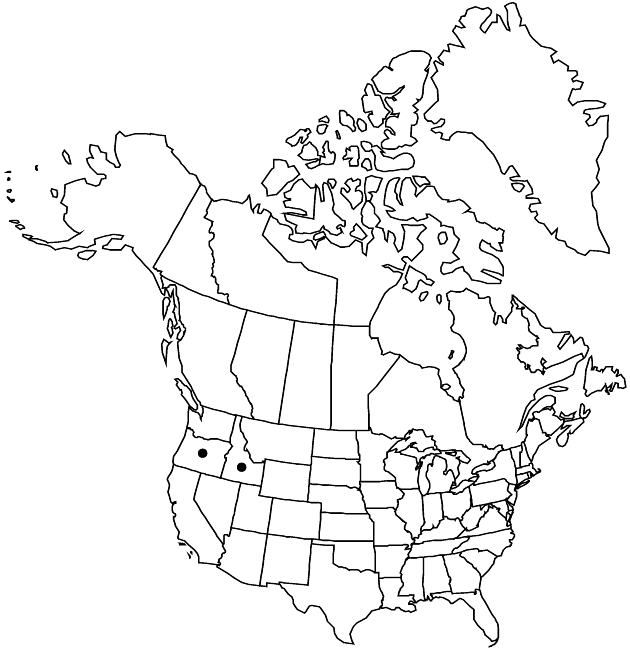Difference between revisions of "Pyrrocoma radiata"
Trans. Amer. Philos. Soc., n. s. 7: 333. 1840.
FNA>Volume Importer |
imported>Volume Importer |
||
| (3 intermediate revisions by 2 users not shown) | |||
| Line 8: | Line 8: | ||
}} | }} | ||
|common_names=Snake River goldenweed | |common_names=Snake River goldenweed | ||
| + | |special_status={{Treatment/ID/Special_status | ||
| + | |code=E | ||
| + | |label=Endemic | ||
| + | }} | ||
|basionyms= | |basionyms= | ||
|synonyms={{Treatment/ID/Synonym | |synonyms={{Treatment/ID/Synonym | ||
|name=Haplopappus carthamoides var. maximus | |name=Haplopappus carthamoides var. maximus | ||
|authority=A. Gray | |authority=A. Gray | ||
| + | |rank=variety | ||
}} {{Treatment/ID/Synonym | }} {{Treatment/ID/Synonym | ||
|name=Haplopappus radiatus | |name=Haplopappus radiatus | ||
|authority=(Nuttall) Cronquist | |authority=(Nuttall) Cronquist | ||
| + | |rank=species | ||
}} | }} | ||
|hierarchy=Asteraceae;Asteraceae tribe Astereae;Pyrrocoma;Pyrrocoma radiata | |hierarchy=Asteraceae;Asteraceae tribe Astereae;Pyrrocoma;Pyrrocoma radiata | ||
| Line 39: | Line 45: | ||
-->{{#Taxon: | -->{{#Taxon: | ||
name=Pyrrocoma radiata | name=Pyrrocoma radiata | ||
| − | |||
|authority=Nuttall | |authority=Nuttall | ||
|rank=species | |rank=species | ||
| Line 53: | Line 58: | ||
|publication title=Trans. Amer. Philos. Soc., n. s. | |publication title=Trans. Amer. Philos. Soc., n. s. | ||
|publication year=1840 | |publication year=1840 | ||
| − | |special status= | + | |special status=Endemic |
| − | |source xml=https:// | + | |source xml=https://bitbucket.org/aafc-mbb/fna-data-curation/src/2e0870ddd59836b60bcf96646a41e87ea5a5943a/coarse_grained_fna_xml/V19-20-21/V20_976.xml |
|tribe=Asteraceae tribe Astereae | |tribe=Asteraceae tribe Astereae | ||
|genus=Pyrrocoma | |genus=Pyrrocoma | ||
Latest revision as of 20:07, 5 November 2020
Plants 40–90 cm. Stems 1–8, usually erect, rarely curved-ascending, pale, rarely reddish, robust, glabrous, eglandular. Leaves: basal (tufted), long-petiolate, blades (pale) broadly elliptic to obovate, 100–500 × 40–200 mm, rigid, margins entire or undulate, occasionally spinulose-serrate, eciliate; cauline reduced and becoming sessile distally, margins entire or sharply spinulose-serrate; faces glabrous. Heads borne singly or 3–12 in short, open corymbiform arrays (subtended by leaflike bracts). Peduncles 2–7 cm. Involucres broadly hemispheric, 20–32 × 25–40 mm. Phyllaries in 5–6 series, loosely appressed, ovate-oblong, unequal, margins pale, entire, eciliate, apices green, tip reflexed, faces glabrous. Ray florets 17–34; corollas inconspicuous, 7–13 mm. Disc florets 80–100; corollas 10–15 mm. Cypselae subcylindric, 6–11 mm, 4-angled, faces glabrous; pappi tawny or brownish, 9–13 mm. 2n = 36.
Phenology: Flowering Jun–Sep.
Habitat: Dry hillsides, alkaline slopes
Elevation: 600–2400 m
Discussion
Pyrrocoma radiata is known only from the southern end of the Snake River canyon in Oregon and Idaho. It is considered endangered in Oregon. It is recognized by its large stature, glabrous herbage, and very large heads. It is most closely related to P. carthamoides and was formerly treated as a variety of that species. It is hexaploid and may be a gigas form of P. carthamoides.
Selected References
None.
